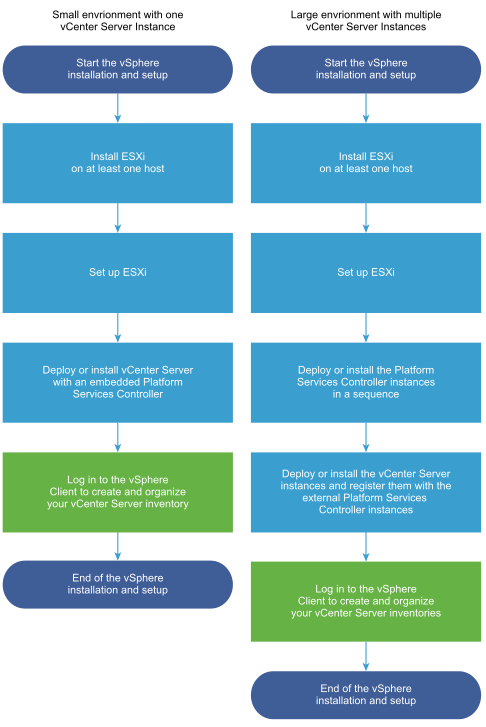vSphere is a sophisticated product with multiple components to install and set up. To ensure a successful vSphere deployment, understand the sequence of tasks required.
Installing vSphere includes the following tasks:

- Read the vSphere release notes.
- Install ESXi.
Note: See VMware ESXi Installation and Setup for detailed information about the ESXi installation process.
- Configure the ESXi boot and network settings, the direct console, and other settings. See VMware ESXi Installation and Setup for information.
- Consider setting up a syslog server for remote logging, to ensure sufficient disk storage for log files. Setting up logging on a remote host is especially important for hosts with limited local storage. See VMware ESXi Installation and Setup
- Determine the vCenter Server and Platform Services Controller deployment model that is suitable for your environment.
See vCenter Server and Platform Services Controller Deployment Types.
- Deploy or install vCenter Server and Platform Services Controller.
You can deploy the vCenter Server Appliance or Platform Services Controller appliance on an ESXi host or vCenter Server instance, or you can install vCenter Server and Platform Services Controller on a Windows virtual machine or physical server.
You can deploy or install multiple vCenter Server instances connected in Enhanced Linked Mode configuration by registering them to a common or different joined Platform Services Controller instances.
- Deploy the vCenter Server Appliance or Platform Services Controller appliance.
- Review the topics in System Requirements for the vCenter Server Appliance and Platform Services Controller Appliance and verify that your system meets the hardware and software requirements for deploying the appliance.
- Determine the deployment method to use.
You can use the GUI method to deploy the appliance interactively. You can use the CLI method to perform a silent deployment of the appliance. See GUI Deployment of the vCenter Server Appliance and Platform Services Controller Appliance and CLI Deployment of the vCenter Server Appliance and Platform Services Controller Appliance.
- Use the topic Required Information for Deploying a vCenter Server Appliance or Platform Services Controller Appliance to create a worksheet with the information you need for the GUI deployment, or use the topic Prepare Your JSON Configuration File for CLI Deployment to create your JSON templates for the CLI deployment.
- Deploy the appliance.
- Install vCenter Server or Platform Services Controller on a Windows virtual machine or physical server.
- Verify that your system meets the hardware and software requirements for installing vCenter Server. See vCenter Server for Windows Requirements.
- (Optional) Set up an external vCenter Server database. See Preparing vCenter Server Databases for Install.
For an environment with up to 20 hosts and 200 virtual machines, you can use the bundled PostgreSQL database. For production and large scale environments, set up an external database, because the migration from the embedded PostgreSQL database to an external database is not a trivial manual process.
- Create a worksheet with the information you need for installation. See Required Information for Installing vCenter Server or Platform Services Controller on Windows.
- Install vCenter Server with an embedded Platform Services Controller, Platform Services Controller, or vCenter Server with an external Platform Services Controller.
- Deploy the vCenter Server Appliance or Platform Services Controller appliance.
- Connect to vCenter Server from the vSphere Client. See After You Install vCenter Server or Deploy the vCenter Server Appliance.
- Configure the vCenter Server Appliance or vCenter Server instance. See vCenter Server Appliance Configuration and vCenter Server and Host Management.